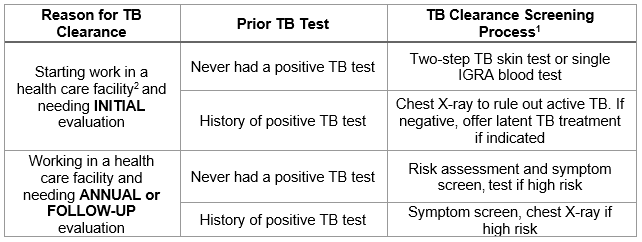Dear Healthcare Provider:
The Hawaiʻi State Department of Health (DOH) TB Control Branch has revised annual TB clearance requirements for health care workers (HCWs). The changes apply to people working in a health care facility or residential care facility licensed or regulated by DOH who are seeking an annual TB clearance.
Hawaiʻi continues to have one of the highest rates of TB in the country. In 2024, Hawaiʻi had over 100 active TB cases or 8.1 cases per 100,000 residents while the average case rate for the U.S. was 2.3 cases per 100,000 residents. Because of this high case rate, continued public health efforts to identify and treat TB are essential for preventing more cases and protecting the health of our communities. Health care workers are considered an important population to evaluate for new TB infections to ensure HCWs with active TB do not transmit it, but also to identify and treat latent TB before it can progress to the active, contagious and deadly form of TB.
In 2016, the Centers for Disease Control and Prevention changed its general guidance regarding TB screening for health care workers and eliminated annual screening in their recommendations. However, these recommendations were based on national data with lower rates of TB and lower rates of acquisition of TB infection (also known as “conversion of a skin test or IGRA”). Because Hawaiʻi’s case rates and HCW conversion rates are higher than the national rates, DOH continues to require annual screening for TB for HCWs.
Prior to this recent change, annual TB screening for HCWs who had never had a positive TB skin test or blood test (IGRA) required repeat testing (skin test or IGRA) to achieve an annual TB clearance. This testing is time consuming and costly. To reduce this burden, DOH has developed an alternative TB screening method that continues annual screening of HCWs but requires testing only for high-risk HCWs.
As of May 2025, health care workers who have never had a positive TB test may receive an annual TB clearance based on a negative State of Hawaiʻi standardized risk assessment and symptom screen (see Attachment). If the risk assessment or symptom screen is positive, the HCW will require negative testing (skin test or IGRA) to receive a TB clearance. This method is expected to increase efficiency and decrease costs of annual TB screening while still identifying HCWs at risk for TB infection.
TB screening for new hires at health care facilities is unchanged, as are screening procedures for people who have previously had a positive TB test. Please refer to the DOH TB Clearance Manual dated May 19, 2025 for more details of these screening procedures.
Table 1: Initial TB Clearance Screening Processes for HCWs

1 Subsequent needed tests will depend on the results of the initial screening.
2 Health care facility is defined as a health care facility or residential care setting licensed or regulated by DOH.
These updated TB Clearance requirements for HCWs maintain effective, targeted screening to identify new cases of latent TB and active TB in Hawaiʻi’s healthcare workforce.
Some health care facilities or health systems may adopt more stringent screening procedures and may continue to require an annual TB skin test or IGRA based on internal infection control policies.
To read the TB Clearance Guidance Manual please visit: https://health.hawaii.gov/tb/files/2025/05/Hawaii-TB-Clearance-Manual_v2_5-19-2025.pdf
If you have any questions or concerns, please contact Dr. Genevieve Ley at the Department of Health TB Control Branch, (808) 832-5535 or genevieve.ley@doh.hawaii.gov.
Sincerely,
Genevieve Ley, MD
Chief, Tuberculosis Control Branch
Diana Felton, MD
Chief, Communicable Diseases & Public Health Nursing Division